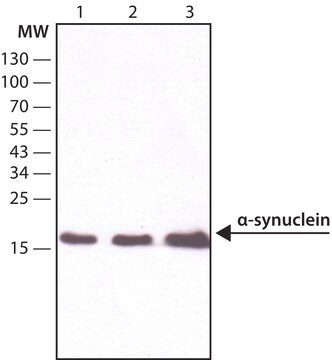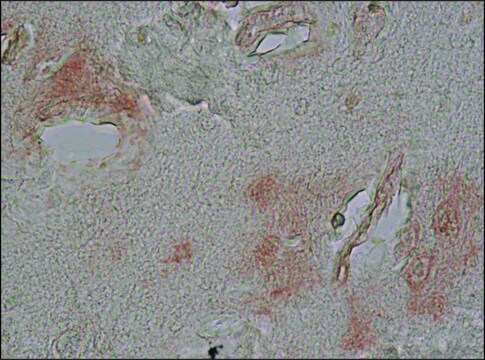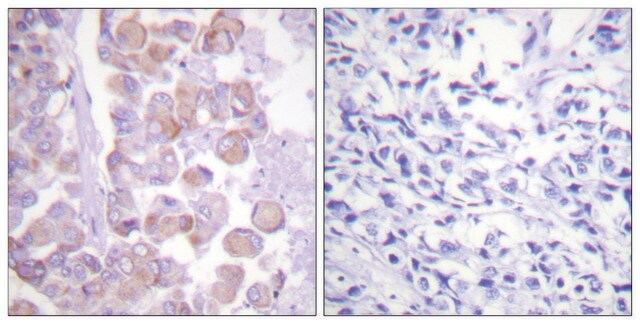ZMS1080
Anti-α-Synuclein Antibody, clone 2F12 ZooMAb® Mouse Monoclonal

recombinant, expressed in HEK 293 cells
別名:
Non-A beta component of AD amyloid
About This Item
IHC (p)
IP
WB
immunohistochemistry (formalin-fixed, paraffin-embedded sections): suitable
immunoprecipitation (IP): suitable
western blot: suitable
おすすめの製品
由来生物
mouse
品質水準
リコンビナント
expressed in HEK 293 cells
結合体
unconjugated
抗体製品の状態
purified antibody
抗体製品タイプ
primary antibodies
クローン
2F12, recombinant monoclonal
製品種目
ZooMAb® learn more
フォーム
lyophilized
分子量
calculated mol wt 14.46 kDa
observed mol wt ~15 kDa
精製方法
using protein G
化学種の反応性
human, rat, mouse
包装
antibody small pack of 25 μL
環境により配慮した代替製品の特徴
Waste Prevention
Designing Safer Chemicals
Design for Energy Efficiency
Learn more about the Principles of Green Chemistry.
強化検証
recombinant expression
Learn more about Antibody Enhanced Validation
sustainability
Greener Alternative Product
テクニック
immunocytochemistry: suitable
immunohistochemistry (formalin-fixed, paraffin-embedded sections): suitable
immunoprecipitation (IP): suitable
western blot: suitable
アイソタイプ
IgG2bκ
エピトープ配列
C-terminal
タンパク質IDアクセッション番号
UniProtアクセッション番号
環境により配慮した代替製品カテゴリ
輸送温度
ambient
保管温度
2-8°C
ターゲットの翻訳後修飾
unmodified
遺伝子情報
human ... SCNA(6622)
詳細
Each ZooMAb® antibody is manufactured using our proprietary recombinant expression system, purified to homogeneity, and precisely dispensed to produce robust and highly reproducible lot-to-lot consistency. Only top-performing clones are released for use by researchers. Each antibody is validated for high specificity and affinity across multiple applications, including its most commonly used application. ZooMAb® antibodies are reliably available and ready to ship when you need them.
特異性
免疫原
アプリケーション
Evaluated by Western Blotting in human thalamus tissue lysate.
Western Blotting Analysis: A 1:1,000 dilution of this antibody detected -Synuclein in human thalamus tissue lysate.
Tested applications
Western Blotting Analysis: A 1:1,000 dilution from a representative lot detected -Synuclein in human brain tissue lysate.
Immunohistochemistry (Paraffin) Analysis: A 1:1,000 dilution from a representative lot detected -Synuclein in human cerebral cortex and rat cerebellum tissue sections.
Immunoprecipitation Analysis: A representative lot of mouse monoclonal antibody (clone 2F12) immunoprecipitated -Synuclein in Immunoprecipitation applications (Courtesy of Tim Bartels, Ph.D., Brigham and Women′s Hospital, Boston, MA).
Immunocytochemistry Analysis: A 1:100 dilution from a representative lot detected -Synuclein in E18 mouse cortical cells.
Note: Actual optimal working dilutions must be determined by end user as specimens, and experimental conditions may vary with the end user
ターゲットの説明
物理的形状
再構成
保管および安定性
法的情報
免責事項
適切な製品が見つかりませんか。
製品選択ツール.をお試しください
保管分類コード
13 - Non Combustible Solids
WGK
WGK 1
適用法令
試験研究用途を考慮した関連法令を主に挙げております。化学物質以外については、一部の情報のみ提供しています。 製品を安全かつ合法的に使用することは、使用者の義務です。最新情報により修正される場合があります。WEBの反映には時間を要することがあるため、適宜SDSをご参照ください。
Jan Code
ZMS1080-4X25UL:
ZMS1080-25UL:
最新バージョンのいずれかを選択してください:
ライフサイエンス、有機合成、材料科学、クロマトグラフィー、分析など、あらゆる分野の研究に経験のあるメンバーがおります。.
製品に関するお問い合わせはこちら(テクニカルサービス)






